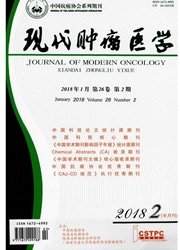

 中文摘要:
中文摘要:
目的:探讨急性儿童系统性EB病毒阳性T细胞淋巴组织增殖性疾病的发病机制、临床病理特征及鉴别诊断要点,以缩短诊断时间和减少误诊。方法:结合文献分析1例急性儿童系统性EB病毒阳性T细胞淋巴组织增殖性疾病死亡病例的临床症状和体征、病理特征及免疫组织化学、EBER原位杂交、基因克隆重排结果等。结果:急性儿童系统性EB病毒阳性T细胞淋巴组织增殖性疾病临床上主要表现为嗜血综合征,包括发热、淋巴结及肝脾肿大、外周血三系减少,可伴有腹水及胸腔积液,血清EB病毒载量增高、血清铁蛋白明显增高,肝肾功能、凝血、血脂等均异常;骨髓涂片示异型淋巴细胞约占18%,并可见嗜血现象。淋巴结活检示其结构破坏,淋巴滤泡减少,T区明显扩大,可见轻-中度异型淋巴细胞;淋巴窦扩张,组织细胞增生,可见嗜血现象,间质血管增生。免疫组化证实EB病毒感染的细胞毒性T细胞构成病变主体;EBER原位杂交部分淋巴细胞胞核阳性;淋巴结组织标本基因重排示TCR基因发生克隆性重排,患者在发病第27天因多脏器衰竭死亡。结论:急性儿童系统性EB病毒阳性T细胞淋巴组织增殖性疾病是一种系统性病变,部分患者病情急剧恶化死于严重并发症。该病病情多较复杂,且与其它疾病存在重叠或交叉,早期确诊困难,目前证实其中T淋巴细胞增生为克隆性增生,为T细胞淋巴瘤。应提高对其病理认识,并紧密结合临床、检验、免疫表型、基因重排等因素,减少治疗延误。
 英文摘要:
英文摘要:
Objective:To explore the pathogenesis,clinicopatholgic features and differential diagnosis of acute systemic EBV-positive T-cell lymphoproliferative disease of childhood(ASEBV+T-LPDC).Methods:One case of ASEBV+T-LPDC was studied with conventional histopathological,immunohistochemical stains and gene rearrangment.Results:The clinical symptoms of ASEBV+T-LPDC includes hemophagocytic syndrome(intermittent fever,the enlargement of lymph nodes,hepatosplenomegaly and hemocytopenia),hydrothorax,ascites,raised serum antibody titre of EBV,increased serum ferritin level,anomalous liver and renal function,thrombosis and hyperlipidemia.18% atypical lymphocytes can be seen in the bone marrow smear.Histologically,the lymph nodes showed extensive expansion of T zones,with diminished or effaced lymphoid follicles.The lymphoid cells were of small to medium size.Phagocytosis of red cell can be found in the lymph node.Also,expansion of lymphatic sinusoid,hyperplasia of histocyte and blood vessel in mesenchyme can be found.The major part of this disease is the EBV infected T-cell demonstrated by EBER hybridization.Conclusion:ASEBV+T-LPDC is a systematic disease with special complex morphology,which carries a poor clinical outcome and can be life-threatening very quickly.The diagnosis of ASEBV+T-LPDC should mainly relies on combination of clinicopathological features and ancillary investigation.The proliferation of T lymphocytes was demonstrated to be monoclonal by the TCR gene clonality examination.
 同期刊论文项目
同期刊论文项目
 同项目期刊论文
同项目期刊论文
 A noninvasive mucinous cystic neoplasm with intermediate-grade dysplasia of the pancreas and extensi
A noninvasive mucinous cystic neoplasm with intermediate-grade dysplasia of the pancreas and extensi Answer to the Clinical Challenges and Images in GI Question: Image 6: Calcifying Fibrous Pseudotumor
Answer to the Clinical Challenges and Images in GI Question: Image 6: Calcifying Fibrous Pseudotumor 期刊信息
期刊信息
